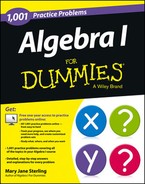Chapter 1
Signing on with Signed Numbers
Signed numbers include all real numbers, positive or negative, except 0. In other words, signed numbers are all numbers that have a positive or negative sign. You usually don't put a plus sign in front of a positive number, though, unless you're doing math problems. When you see the number 7, you just assume that it's +7. The number 0 is the only number that isn't either positive or negative and doesn't have a plus or minus sign in front of it; it's the dividing place between positive and negative numbers.
The Problems You'll Work On
As you work with signed numbers (and positive and negative values), here are the types of problems you'll do in this chapter:
What to Watch Out For
Pay careful attention to the following items when working on the signed number problems in this chapter:
Placing Real Numbers on the Number Line
1–6 Determine the correct order of the numbers on the real number line.
1. Determine the order of the numbers:
−3, 4, −1, 0, −4
2. Determine the order of the numbers:
−3, 3, −2, 0, 1
3. Determine the order of the numbers:
![]()
4. Determine the order of the numbers:
![]()
5. Determine the order of the numbers:
![]()
6. Determine the order of the numbers:
![]()
Using the Absolute Value Operation
7–10 Evaluate each expression involving absolute value.
7. |−4|
8. |−7.6|
9. −|−2|
10. ![]()
Adding Signed Numbers
11–20 Find the sum of the signed numbers.
11. −4 + (−2) =
12. 2 + (−4) =
13. −2 + 4 =
14. −5 + 3 =
15. −6 + 6 =
16. 7 + (−2) =
17. 5 + (−4) + (−2) =
18. −1 + 2 + (−3) + 4 =
19. −67 + 68 + (−69) + 70 =
20. −4 + (−5) + (−6) + (−7) + 7 + 4 =
Subtracting Signed Numbers
21–30 Find the difference between the signed numbers.
21. −4 − 6 =
22. 7 − (−8) =
23. 6 − 3 =
24. −9 − (−4) =
25. −7 − 7 =
26. −7 − (−7) =
28. −[−2] −3 =
29. −[−4] −(−4) =
30. 0 −(−5) =
Multiplying and Dividing Signed Numbers
31–50 Find the products and quotients involving signed numbers.
31. 2(−3) =
32. −4(−5) =
33. −5(6) =
34. 3(−1) =
35. (−7)(−7) =
36. (−8)(8) =
37. ![]()
38. ![]()
39. −2(0) =
40. (−1)(−1)(−1)(−1) =
41. ![]()
43. ![]()
44. ![]()
45. ![]()
46. ![]()
47. ![]()
48. ![]()
49. ![]()
50. ![]()
